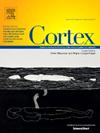典型成像仪和幻觉的视觉心理意象:一项毫米尺度的7-T fMRI研究
IF 3.2
2区 心理学
Q1 BEHAVIORAL SCIENCES
引用次数: 0
摘要
我们大多数人毫不费力地描述视觉对象,无论是看到的还是记住的。然而,大约4%的人报告先天性幻觉:尽管能够描述他们的视觉外观,但他们很难想象物体。是什么神经机制造成了主观体验和客观表现之间的差异?幻像症可以为意识处理和意识提供新的见解。本研究利用超高场7T功能磁共振成像(fMRI)技术建立了先天性失认症中涉及视觉心理意象和知觉的神经回路,并探讨了在缺乏意象体验的情况下,先天失认症内部产生的视觉信息加工的相关神经机制。10名典型成象者和10名失忆者在5个领域完成了图像和感知任务:物体形状、物体颜色、文字、面孔和空间关系。在典型的成象者中,成像任务激活了左半球额顶叶区、颞叶腹侧皮层相关的区域偏好区与感知区域偏好区部分重叠,以及左梭状回的区域通用区(梭状回成像节点)。结果对每个参与者都有效。在失忆个体中,图像激活了类似的视觉区域,但梭状回图像节点和额顶叶区域之间的功能连接减少。我们的研究结果揭示了视觉心理意象的一般领域和特定领域回路,以及它们在失视症中的功能紊乱,并支持了有意识的视觉体验——无论是感知的还是想象的——取决于高级视觉皮层和额顶叶网络的综合活动的一般假设。本文章由计算机程序翻译,如有差异,请以英文原文为准。
Visual mental imagery in typical imagers and in aphantasia: A millimeter-scale 7-T fMRI study
Most of us effortlessly describe visual objects, whether seen or remembered. Yet, around 4% of people report congenital aphantasia: they struggle to visualize objects despite being able to describe their visual appearance. What neural mechanisms create this disparity between subjective experience and objective performance? Aphantasia can provide novel insights into conscious processing and awareness. We used ultra-high field 7T fMRI to establish the neural circuits involved in visual mental imagery and perception, and to elucidate the neural mechanisms associated with the processing of internally generated visual information in the absence of imagery experience in congenital aphantasia. Ten typical imagers and 10 aphantasic individuals performed imagery and perceptual tasks in five domains: object shape, object color, written words, faces, and spatial relationships. In typical imagers, imagery tasks activated left-hemisphere frontoparietal areas, the relevant domain-preferring areas in the ventral temporal cortex partly overlapping with the perceptual domain-preferring areas, and a domain-general area in the left fusiform gyrus (the Fusiform Imagery Node). The results were valid for each individual participant. In aphantasic individuals, imagery activated similar visual areas, but there was reduced functional connectivity between the Fusiform Imagery Node and frontoparietal areas. Our results unveil the domain-general and domain-specific circuits of visual mental imagery, their functional disorganization in aphantasia, and support the general hypothesis that conscious visual experience - whether perceived or imagined - depends on the integrated activity of high-level visual cortex and frontoparietal networks.
求助全文
通过发布文献求助,成功后即可免费获取论文全文。
去求助
来源期刊

Cortex
医学-行为科学
CiteScore
7.00
自引率
5.60%
发文量
250
审稿时长
74 days
期刊介绍:
CORTEX is an international journal devoted to the study of cognition and of the relationship between the nervous system and mental processes, particularly as these are reflected in the behaviour of patients with acquired brain lesions, normal volunteers, children with typical and atypical development, and in the activation of brain regions and systems as recorded by functional neuroimaging techniques. It was founded in 1964 by Ennio De Renzi.
 求助内容:
求助内容: 应助结果提醒方式:
应助结果提醒方式:


